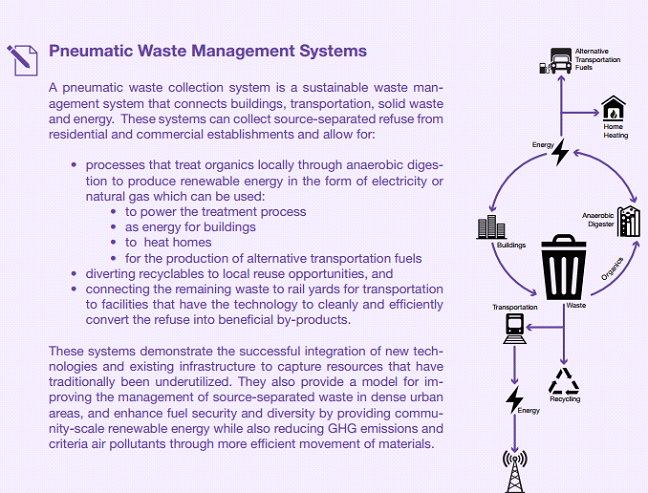News | MetroFreight Research in Action: Pneumatic Waste Collection System
Stop the VideoNews

METRANS UTC MetroFreight
MetroFreight Research in Action: Pneumatic Waste Collection System
Monday, October 24, 2016
Benjamin Miller, Senior Research Fellow, Freight Programs, University Transportation Research Center in New York (and his colleagues [or: partners]) have moved their MetroFreight research project on waste management into the pre-implementation feasibility-analysis phase. For Trucks, Trains, Tugs, and Tubes: A Model for More-Efficient Collection and Transfer of Solid Waste, the Predominant Form of First-Mile Urban Freight, they studied the feasibility of retrofitting neighborhoods with pneumatic tubes by piggy-backing on existing infrastructure—a concept they had first examined in a 2013 report for two New York State agencies.
In the New York City neighborhoods that they studied, they found it to be physically and operationally feasible to achieve substantial reductions in truck miles, greenhouse gas emissions, and long-term costs. Now, with a second round of funding from New York State, support from the City of New York, and the participation of major building owners, they’re conducting the pre-planning analyses that are pre-requisites for construction. Their High Line Corridor pneumatic waste-management initiative would affix a pneumatic tube to the underside of the 1.5-mile-long High Line Park viaduct to offer pneumatic-collection of three waste fractions (refuse, recyclables, and organics) to a swath of the rapidly developing Far West Side of Manhattan. Compacted containers of these materials would be directly transferred from the pneumatic terminal to rail cars, restoring freight use to an underutilized urban rail line to deliver these materials directly to processing and disposal facilities without trucks. A second, small-diameter pneumatic tube would collect pre-consumer food waste from restaurant kitchens along the corridor for direct delivery to a small-scale anaerobic digestion facility that could supply the electricity to power both pneumatic systems.
Miller’s project is the only one in the world to have proposed connecting pneumatic collection directly to an anaerobic digester, or to rail, or to use existing infrastructure as a means to avoid tunneling. The NYC Mayor’s Office cited the characteristics of this proposal as an example of the type of waste-management strategy that could help the City achieve some of its core policy objectives. New York City’s Roadmap to 80 X 50 [80% reduction in greenhouse gases by 2050] was released September 2016.

For the Full Report, Download Here
Other publications:
“Pneumatic Tubes for One New York’s Trash,” Juliette Spertus, Benjamin Miller; Urban Omnibus, 2015
" 'Giant Vacuum Cleaner' Could Replace Current Trash Sysm on the High Line," Maya Rajamani, 2016

Benjamin Miller is the senior research associate for Freight Programs at the University Transportation Research Center, Region II and the co-founder of CLOSEDLOOPS. A former director of policy planning for the New York City Department of Sanitation (where he was project manager and principal author of the City’s first Solid Waste Management Plan), he is the author of Fat of the Land: Garbage in New York, the Last 200 Years and numerous reports and articles on environmental policy issues.
News Archive
- December (1)
- November (6)
- October (4)
- September (2)
- August (3)
- July (4)
- June (3)
- May (7)
- April (8)
- March (11)
- February (8)
- January (7)
- December (7)
- November (8)
- October (11)
- September (11)
- August (4)
- July (10)
- June (9)
- May (2)
- April (12)
- March (8)
- February (7)
- January (11)
- December (11)
- November (5)
- October (16)
- September (7)
- August (5)
- July (13)
- June (5)
- May (5)
- April (7)
- March (5)
- February (3)
- January (4)
- December (4)
- November (5)
- October (5)
- September (4)
- August (4)
- July (6)
- June (8)
- May (4)
- April (6)
- March (6)
- February (7)
- January (7)
- December (8)
- November (8)
- October (8)
- September (15)
- August (5)
- July (6)
- June (7)
- May (5)
- April (8)
- March (7)
- February (10)
- January (12)















